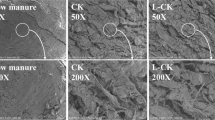Abstract
The effects of copper, chromium, and zinc ions, at trace levels, on the performance of a simulated activated sludge process were investigated. The results of batch adsorption experiments showed that the adsorption of copper, chromium, and zinc ions followed both the Langmuir and Freundlich isotherms. The presence of trace levels of these three metals not only reduced the adsorption rate of organic matters but also the chemical oxygen demand adsorption capacity (CAC) of the activated sludge. Metal ions competed with the organic substrate for adsorption binding sites on the surfaces of activated sludge bioflocs and reduced the CAC. Studies performed in a sequential batch reactor (SBR) showed that the presence of trace levels of heavy metal ions in wastewater affected the SBR performance to different extents depending on the hydraulic retention time (HRT). When the reactors were operated at short HRTs of 2.5 d or less, the presence of trace levels of heavy metal ions reduced substantially the CAC of activated sludge, which, in turn, affected significantly the performance of the SBR. However, under longer HRTs (e.g., 5d), the heavy metal ions in the wastewater reduced the CAC but had not significant effect on the chemical oxygen demand removal efficiency.
Similar content being viewed by others
References
Sawver, C. N., McCarty, P. I., and Parkin, G. F. (1994), Chemistry for Environmental Engineering, McGraw-Hill, Singapore, pp. 633–636.
Brown, M. J. and Lester, J. N. (1979), Water Res. 13, 817–837.
Nelson, P. O., Chung, A. K., and Hudson, M. C. (1981), J. Water Pollut. Control Fed. 53, 1323–1333.
Battistoni, P., Fava, G., and Ruello, M. L. (1993), Water Res. 27(5), 821–827.
Codina, J. C., Perez-Garcia, A., and de Vicente, A. (1994), Water Sci. Technol. 30 (10), 145–151.
Zarnovsky, L., Derco, J., Kuffa, R., and Drtil, M. (1994), Water Sci. Technol. 30(11), 235–242.
Suthirak, S. and Sherrard, J. H. (1981), J. Water Pollut. Control Fed. 53, 1314–1332.
Dilek, F. B., Gokcay, C. E., and Yetis U. (1998), Water Res. 23, 302–312.
Chang, S. Y., Huang, J. C., and Liu, Y. C. (1986), J. Environ. Eng. 112, 1, 94–104.
Hong Kong Environmental Protection Department. (1998), Environment Hong Kong 1998—A Review of 1997, Hong Kong Government Printer, Hong Kong SAR.
Hong Kong Drainage Services Department. (1991), Technical Memorandum: Standards for Effluent Discharged into Drainage and Sowerage Systems, Inland Water and Coastal Waters, Hong Kong Government Printer, Hong Kong SAR.
Wong, K. Y., Zhang, M. Q., Li, X. M., and Lo, W. (1997), Biosens. Bioelectron. 12(2), 125–133.
Tan, K. N. and Chua, H. (1997), Environ. Monitor. Assess. 44, 211–217.
Tan K. N. (1993), MS thesis, National University of Singapore, Singapore.
Lo, W., Chua, H., Lam, K. H., and Bi, S. P. (1999). Chemosphere 39(15), 2723–2736.
American Public Health Association. (1995), Standard Methods for the Examination of Water and Wastewater, 19th ed., American Public Health Association, Washington, DC.
Chong, H. K. and Volesky, B. (1995), Biotechnol. Bioeng. 47, 451–460.
Author information
Authors and Affiliations
Corresponding author
Rights and permissions
About this article
Cite this article
Sin, S.N., Chua, H., Lo, W. et al. Effects of trace levels of copper, chromium, and zinc ions on the performance of activated sludge. Appl Biochem Biotechnol 84, 487–500 (2000). https://doi.org/10.1385/ABAB:84-86:1-9:487
Issue Date:
DOI: https://doi.org/10.1385/ABAB:84-86:1-9:487




